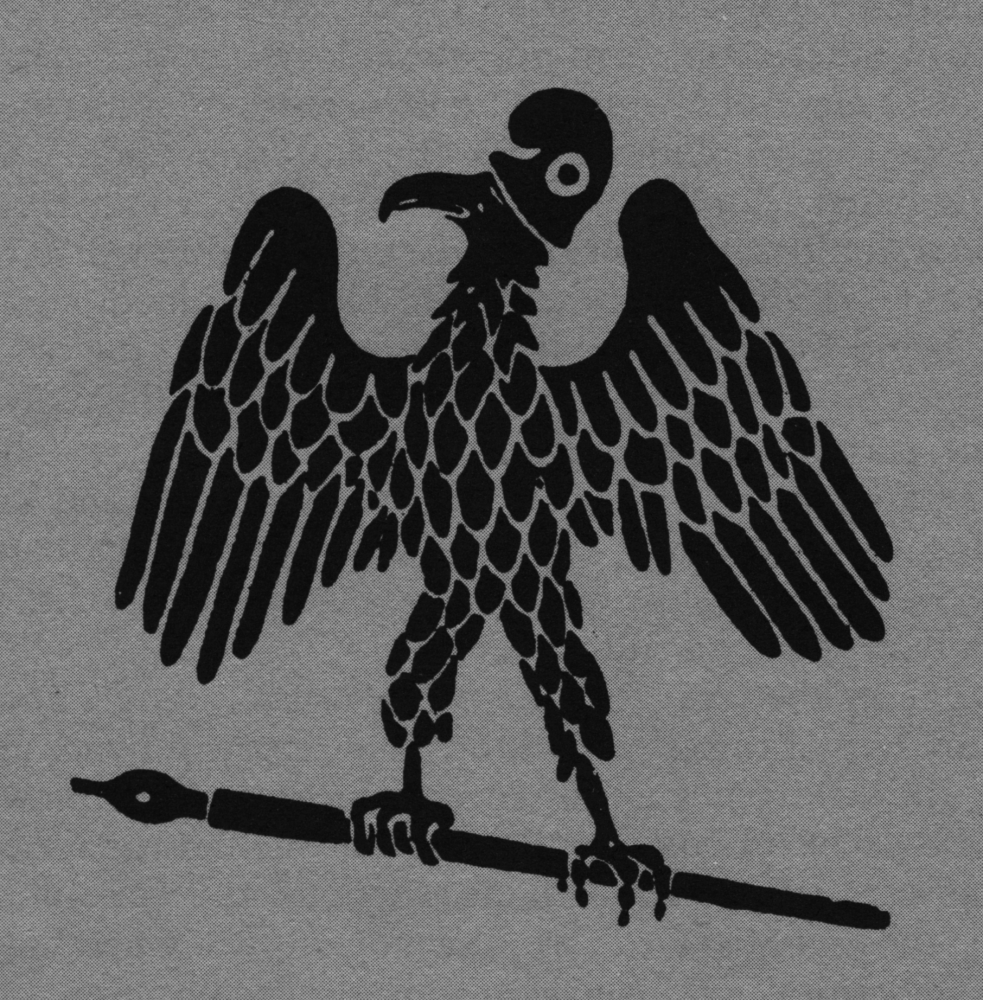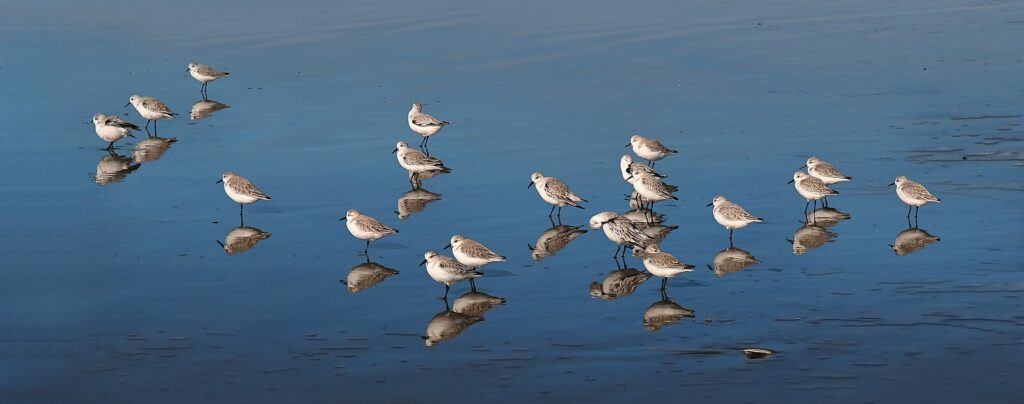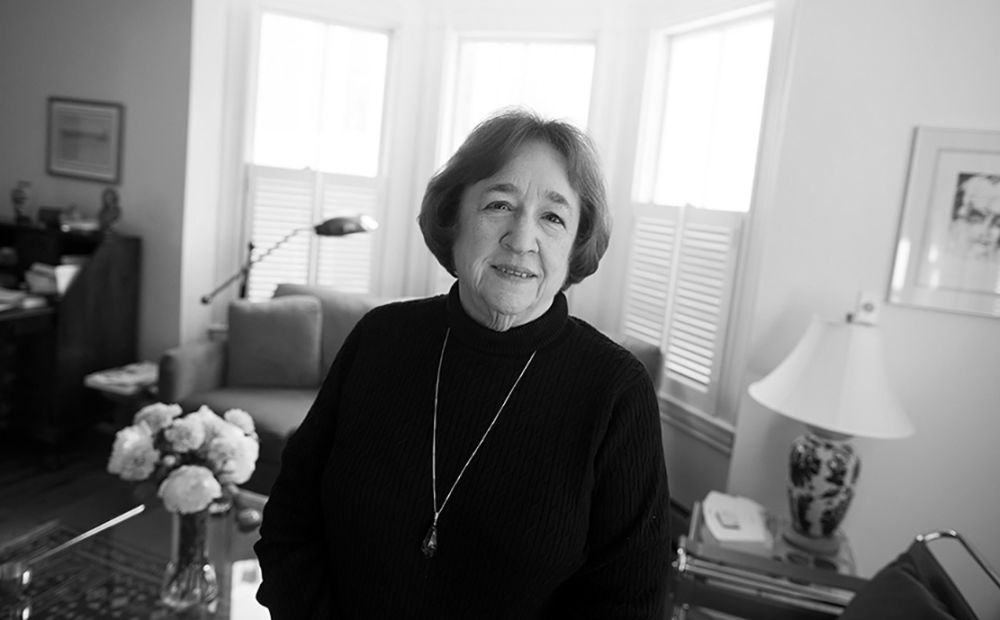Issue 79, Spring 1981

The Paris Review Eagle, or “the bird” as it was referred to, was designed by William Pène du Bois, the magazine’s art editor, in the spring of 1952. The symbolism is not difficult: an American eagle is carrying a pen: the French association is denoted by the helmet the bird is wearing—actually a Phrygian hat originally given a slave on his freedom in ancient times and which subsequently became the liberty cap or bonnet rouge worn by the French Revolutionists of the 19th Century. The bird adorned the top left hand corner of the magazine’s covers until issue number 27 when the artist Larry Rivers utilized the entire space with his design of a winged helmet; the bird, to the regret of some, vanished never to appear again, at least on the magazine’s covers. It did put in an appearance at the New York World’s Fair (1964-65) on a pair of metal pennants that hung from the crosstrees of the center pole of the Paris Review Booth (“The Smallest Pavillion at the Fair”) until the flags blew off in a summer wind storm.
The Paris Review Sketchbook
The first talks about the Paris Review were between Peter Matthiessen, in Paris with his beautiful young wife Patsy, and Harold L. (Doc) Humes, who had arrived in Paris not long before. Peter was then at work on his first novel Race Rock; Doc was already the flamboyant publisher (he carried a silver-headed cane and wore a beret) of a magazine called the Paris News-Post—once described by John Ciardi as “the best fourth-rate imitation of the New Yorker I have ever seen.” Among the names proposed for the new enterprise, and subsequently discarded, was Manuscript (what would have become, had it stuck, Ms.); it was thought bland.
Peter Matthiessen had met Humes in the Dôme in Montparnasse in the spring of 1951. “He was a remarkable figure,” Matthiessen remembered. “He wore a cape…burly and curly fellow with a deep laugh…a lot of style to him; he was appealing, aggressive, warm-hearted, curious, yet with convictions on every subject…all of which made him impossible. Doc wanted me to serve as fiction editor at the Paris News-Post, but the first story I acquired—“The Sun and the Still-Born Stars,” by a young unknown writer named Terry Southern—was so much better than his magazine that I persuaded him to put to death the Paris News-Post and start a new literary magazine, using Terry’s story all over again, which we did.”
Humes was expected to function as the first managing editor of the Paris Review. From his short experience with the Paris News-Post he was supposed to know something about the process of putting out and distributing a magazine: he knew the jargon of the printing shops. But, instead of doing what was expected of him, he took to reading Huckleberry Finn in the corners of the Montparnasse cafés, a supérieur of beer in front of him. He explained that it was best for the young staff of the Review to learn for itself. As its managing editor, he was doing the magazine a favor by remaining aloof from its activities. Besides, he had decided to become a writer; administrative work was behind him. That first summer of 1953 he applied to Harvard as a graduate student and was accepted. Archibald MacLeish took him into his English writing course. He left for the United States.
Those who put out the first issue of the magazine that summer in Paris took umbrage at Humes’s concept of his duties as managing editor. Somewhat peremptorily perhaps—since they forgot to inform him—they lowered him down the masthead to the position of Advertising and Circulation Manager—a somewhat curious title in retrospect, since he had as little to do with these departments as he did with managing.
Humes’s debasement came to his attention when the first shipment of magazines arrived in New York. He was furious. He hurried down from Cambridge. He had a rubber stamp made up with his name and an exalted title. Down on the wharves he got into the shipping crates where he began stamping the masthead page of the magazine in red ink, half a thousand copies or so, until his arm got tired.
Such was Humes’s indignation that in the next issue he was promoted and he appeared at the top of the masthead—along with Peter Matthiessen, the fiction editor, George Plimpton, who had arrived from Cambridge University at the invitation of Matthiessen to be the Editor and assume the active responsibility for the magazine, William Pène du Bois, the art editor, and Donald Hall, the poetry editor. Humes remained at that level until the fourth number of the Paris Review when still having done little discernible for the magazine he was shifted once again and designated an advisory editor—this time without visible rancor on his part, or stamping of inkpads.
John Train took over most of Harold Humes’s responsibilities. He liked to refer to himself as the “so-called managing editor.” He was the magazine’s managing editor until one day in 1954, after a year of organizing things in the office, he left a note in his In-box stating, “Do not put anything in this box.” By this he meant to tell the rest of the staff that he was moving on to something else.
He was a Harvard graduate (an editor of the Lampoon there), with a master’s degree in Comparative Literature. His clipped, wry perception of things was what one might associate with an Oxford don rather than a young graduate newly arrived in Paris. He would not suffer fools or people who bored him. Those he wished to discourage were diverted with an invitation to an address in Montparnasse where Train said he lived. There on a large sheet-iron gate on a wall too high for the visitor to see that behind it was a vacant lot, Train gummed his calling-card which, on occasion, he would replace. The hopeful guest, spotting it, would bend to read in Train’s neat hand: PLEASE KNOCK LOUDLY.
What Train recalls of the Review’s earliest days follows:
One proposition we all agreed on and did achieve was that we wanted to get away from the style of most of the other American literary quarterlies, with Partisan Review in the lead, which were steeped in literary and political theory, as were our French counterparts. I doubt if there was a single French literary magazine at that time that didn’t reflect some specific political orientation. You were not considered serieux unless you were politically engagé—no matter with what. I, on the contrary, after my postgraduate work in Comparative Literature, was convinced that theories, both literary and political, are the enemy of art.
My eyes were opened on this subject by Bernard Berenson. I was Staying with him in Vallombrosa, and one day accompanied him on one of his little walks, meaning not much walk and a lot of talk. Turned out in perfect light tweeds and carrying a small folded shawl over one arm, he would inch along, holding forth exquisitely. When you got a foot or so ahead he would clutch you by the elbow, spinning you around toward him, and make a point. One would then straighten out, resume the march and carry on until the next spin-around. On the occasion in question I was describing my objective of getting a doctorate in comparative literature when I noticed that B.B.’s expression seemed to have clouded slightly. “What do you think of Comp. Lit.?” I asked a bit anxiously. B.B. frowned and reflected, clutched my elbow, spun me around, and bayed hoarsely, “Comp. Lit. is dead as cold mutton!” He meant that to deflect one’s gaze—in one’s all too limited time—from art itself to forms of words about art was a big step down from the juicy reality toward the dry and derivative.
Anyway, at the Paris Review we were united on that point: no learned articles on who influenced whom, or the higher significance of whatever; just the prime matter, except perhaps for occasional newsy pieces on what was brewing on the European literary and artistic scene.
We had trouble over the name. There were, as might be imagined, innumerable suggestions. I claim to have devised the name Paris Review, and lobbied for its acceptance. I remember calling on our group one by one to push it. It seemed so logical: Paris, for the slightly exotic appeal— greater then than now—and because that was our distinguishing feature; Review because that’s what it was.
We took a long time getting started. Raising money was a problem, since although we expected to make money, nobody else could see any basis for that hope, particularly since we were in fact totally unbusiness like. (I doubt if the corporation has had even one shareholder’s meeting since its inception.) We worked out a deal to be sponsored for legal and house-keeping purposes by La Table Ronde, an established French magazine considered to have a conservative political tone although that meant nothing to us.
George came up with a money-making scheme of lofty simplicity. We would approach the Paris Herald-Tribune, he announced. Surely someone knew somebody there. We would offer to do a literary page in each issue; a whole page, filled with stimulating criticism, moving poetry, gripping fiction. We would make so much money from our page that the Review—and its editors—would be in clover. And how would we shoehorn this extra matter into the newspaper’s already congested format? Quite simple, George blandly explained. The Trib would simply chuck the stock pages. After all, none of us read the stock pages, did we?
To provide a keynoter for the first issue we turned to Bill Styron, who, in his late twenties and already a published author, was an elder spokesman of the group. He seemed very worldly-wise. After a while he produced a laborious piece wrestling with his own particular literary theories. It was my task to edit this effusion, and I blue-penciled it with vigor. Styron, nettled, fired back a rejoinder which unlike the original submission had feeling and strength, and, labeled “Letter to an Editor” (me), started the issue in good style. He took a whack at writers who used “terms like…Zeitgeist,” which, as a person of scholarly bent who was comfortable with the word, I somewhat resented. “As for Zeitgeist,” Styron riposted in his inaugural Letter, “which you accuse me of denouncing unintelligently, I still don’t like it, perhaps because I am ignorant of what it means.” (That problem seems at last to have been solved, since the word turns up here and there in Bill’s latest novel, Sophie’s Choice.)




